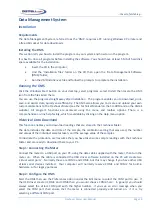
...the
art
of
distell
‐
ing...
Freshness
Meter
User
Manual
Page
10
Getting
started
Verify
that
battery
has
been
charged.
Switch
on
Switch
on
the
Meter
and
allow
the
meter
to
cycle
through
its
start
up
procedure.
Part
of
the
start
up
procedure
is
to
show
how
many
readings
are
currently
stored
in
the
meter.
You
may
wish
to
download
and
erase
any
stored
readings
before
taking
new
measurements.
You
can
find
out
about
the
download
procedure
in
the
section.
After
around
15
seconds
the
meter
is
ready
for
use.
The
display
will
show
the
last
calibration
setting
used,
and
will
look
something
like
the
example
below:
Calibration
Setting
T O R R Y - 1
Y S N = 3 N
Yes
Number
of
samples used
to
calculate
average
No
Measuring
product
samples
Have
a
copy
of
the
organoleptic
charts
at
hand.
For
best
accuracy
always
follow
the
measurement
recommendations
in
this
manual.
Before
starting
we
recommend
you
carry
out
some
checks:
1.
Check
that
you
have
set
the
correct
number
of
samples,
from
1
to
16,
from
the
Samples
menu.
2.
Check
that
you
have
selected
the
correct
calibration
setting
on
the
meter
for
the
fish
being
sampled.
3.
Check
to
ensure
that
you
have
prepared
or
have
been
supplied
with
an
organoleptic
chart
suitable
for
this
fish
species.
4.
Select
the
fish
samples
at
random
from
the
batch.
Where
you
are
taking
fish
samples
from
a
varied
batch,
the
samples
should
be
grouped
according
to
size
(length
/
weight).
5.
Check
that
temperature
of
the
fish
to
be
measured
is
between
0
and
10°C,
with
no
ice
crystals
present
in
the
samples.
The
measurement
procedure
is
outlined
as
follows:
1.
Ensure
that
the
sensor
is
placed
firmly
against
the
skin
of
the
fish,
thus
ensuring
that
there
are
no
air
pockets
between
the
sensor
and
the
sample
to
be
measured.
Press
the
Read
/
Yes
button;
the
Meter
will
confirm
contact
with
the
fish,
take
the
measurement,
display
and
store
the
value.
2.
If
you
see
‘No
Contact’
displayed
on
the
meter
then
check
that
the
sensor
is
making
good
contact
with
the
skin
of
the
fish.
The
meter
will
not
take
any
readings
until
it
detects
good
skin
contact.
3.
For
best
results
be
consistent.
Always
place
the
sensor
on
the
same
part
of
each
fish.
This
will
ensure
that
you
achieve
optimum,
comparable
results.
It
is
normal
to
experience
variability
in
the
individual
readings
when
taken
at
different
parts
of
the
fish.
Note
also
that
different
parts
of
the
fish
will
spoil
at
different
rates,
depending
upon
the
level
of
bacteriological
activity
present
within
the
fish.
4.
One
set
of
readings
should
be
taken
from
each
fish,
at
the
recommended
measurement
sites.
The
results
will
be
stored
in
the
Freshness
Meter
for
later
downloading.

























